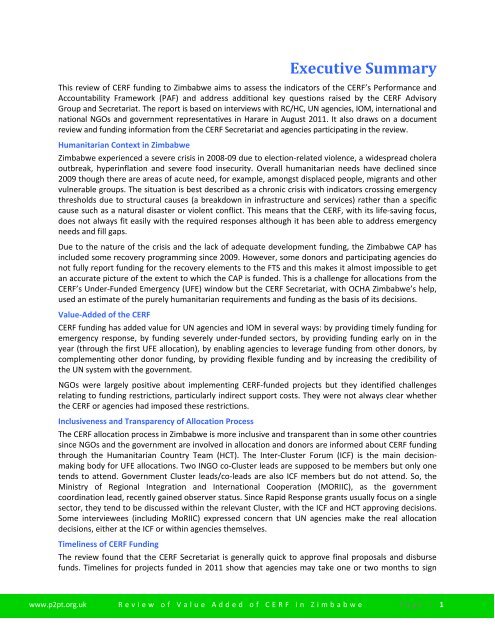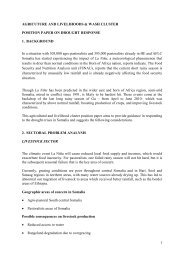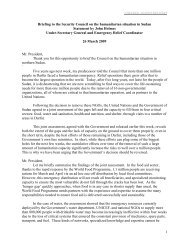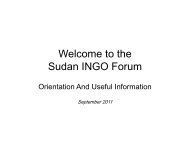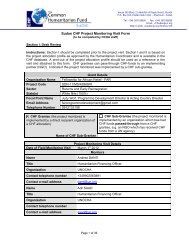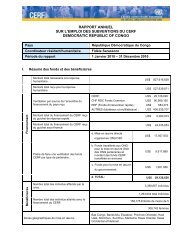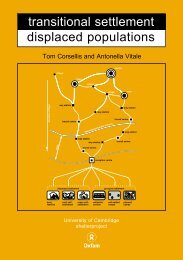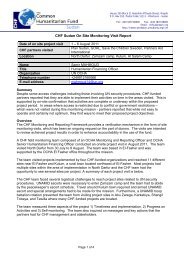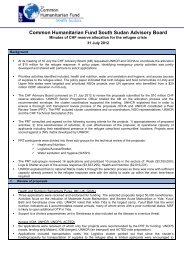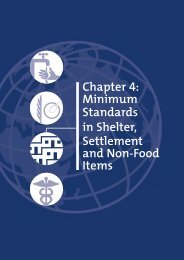in Zimbabwe - OCHANet
in Zimbabwe - OCHANet
in Zimbabwe - OCHANet
Create successful ePaper yourself
Turn your PDF publications into a flip-book with our unique Google optimized e-Paper software.
Executive Summary<br />
This review of CERF fund<strong>in</strong>g to <strong>Zimbabwe</strong> aims to assess the <strong>in</strong>dicators of the CERF’s Performance and<br />
Accountability Framework (PAF) and address additional key questions raised by the CERF Advisory<br />
Group and Secretariat. The report is based on <strong>in</strong>terviews with RC/HC, UN agencies, IOM, <strong>in</strong>ternational and<br />
national NGOs and government representatives <strong>in</strong> Harare <strong>in</strong> August 2011. It also draws on a document<br />
review and fund<strong>in</strong>g <strong>in</strong>formation from the CERF Secretariat and agencies participat<strong>in</strong>g <strong>in</strong> the review.<br />
Humanitarian Context <strong>in</strong> <strong>Zimbabwe</strong><br />
<strong>Zimbabwe</strong> experienced a severe crisis <strong>in</strong> 2008‐09 due to election‐related violence, a widespread cholera<br />
outbreak, hyper<strong>in</strong>flation and severe food <strong>in</strong>security. Overall humanitarian needs have decl<strong>in</strong>ed s<strong>in</strong>ce<br />
2009 though there are areas of acute need, for example, amongst displaced people, migrants and other<br />
vulnerable groups. The situation is best described as a chronic crisis with <strong>in</strong>dicators cross<strong>in</strong>g emergency<br />
thresholds due to structural causes (a breakdown <strong>in</strong> <strong>in</strong>frastructure and services) rather than a specific<br />
cause such as a natural disaster or violent conflict. This means that the CERF, with its life‐sav<strong>in</strong>g focus,<br />
does not always fit easily with the required responses although it has been able to address emergency<br />
needs and fill gaps.<br />
Due to the nature of the crisis and the lack of adequate development fund<strong>in</strong>g, the <strong>Zimbabwe</strong> CAP has<br />
<strong>in</strong>cluded some recovery programm<strong>in</strong>g s<strong>in</strong>ce 2009. However, some donors and participat<strong>in</strong>g agencies do<br />
not fully report fund<strong>in</strong>g for the recovery elements to the FTS and this makes it almost impossible to get<br />
an accurate picture of the extent to which the CAP is funded. This is a challenge for allocations from the<br />
CERF’s Under‐Funded Emergency (UFE) w<strong>in</strong>dow but the CERF Secretariat, with OCHA <strong>Zimbabwe</strong>’s help,<br />
used an estimate of the purely humanitarian requirements and fund<strong>in</strong>g as the basis of its decisions.<br />
Value‐Added of the CERF<br />
CERF fund<strong>in</strong>g has added value for UN agencies and IOM <strong>in</strong> several ways: by provid<strong>in</strong>g timely fund<strong>in</strong>g for<br />
emergency response, by fund<strong>in</strong>g severely under‐funded sectors, by provid<strong>in</strong>g fund<strong>in</strong>g early on <strong>in</strong> the<br />
year (through the first UFE allocation), by enabl<strong>in</strong>g agencies to leverage fund<strong>in</strong>g from other donors, by<br />
complement<strong>in</strong>g other donor fund<strong>in</strong>g, by provid<strong>in</strong>g flexible fund<strong>in</strong>g and by <strong>in</strong>creas<strong>in</strong>g the credibility of<br />
the UN system with the government.<br />
NGOs were largely positive about implement<strong>in</strong>g CERF‐funded projects but they identified challenges<br />
relat<strong>in</strong>g to fund<strong>in</strong>g restrictions, particularly <strong>in</strong>direct support costs. They were not always clear whether<br />
the CERF or agencies had imposed these restrictions.<br />
Inclusiveness and Transparency of Allocation Process<br />
The CERF allocation process <strong>in</strong> <strong>Zimbabwe</strong> is more <strong>in</strong>clusive and transparent than <strong>in</strong> some other countries<br />
s<strong>in</strong>ce NGOs and the government are <strong>in</strong>volved <strong>in</strong> allocation and donors are <strong>in</strong>formed about CERF fund<strong>in</strong>g<br />
through the Humanitarian Country Team (HCT). The Inter‐Cluster Forum (ICF) is the ma<strong>in</strong> decisionmak<strong>in</strong>g<br />
body for UFE allocations. Two INGO co‐Cluster leads are supposed to be members but only one<br />
tends to attend. Government Cluster leads/co‐leads are also ICF members but do not attend. So, the<br />
M<strong>in</strong>istry of Regional Integration and International Cooperation (MORIIC), as the government<br />
coord<strong>in</strong>ation lead, recently ga<strong>in</strong>ed observer status. S<strong>in</strong>ce Rapid Response grants usually focus on a s<strong>in</strong>gle<br />
sector, they tend to be discussed with<strong>in</strong> the relevant Cluster, with the ICF and HCT approv<strong>in</strong>g decisions.<br />
Some <strong>in</strong>terviewees (<strong>in</strong>clud<strong>in</strong>g MoRIIC) expressed concern that UN agencies make the real allocation<br />
decisions, either at the ICF or with<strong>in</strong> agencies themselves.<br />
Timel<strong>in</strong>ess of CERF Fund<strong>in</strong>g<br />
The review found that the CERF Secretariat is generally quick to approve f<strong>in</strong>al proposals and disburse<br />
funds. Timel<strong>in</strong>es for projects funded <strong>in</strong> 2011 show that agencies may take one or two months to sign<br />
www.p2pt.org.uk Review of Value Added of CERF <strong>in</strong> <strong>Zimbabwe</strong> Page | 1


